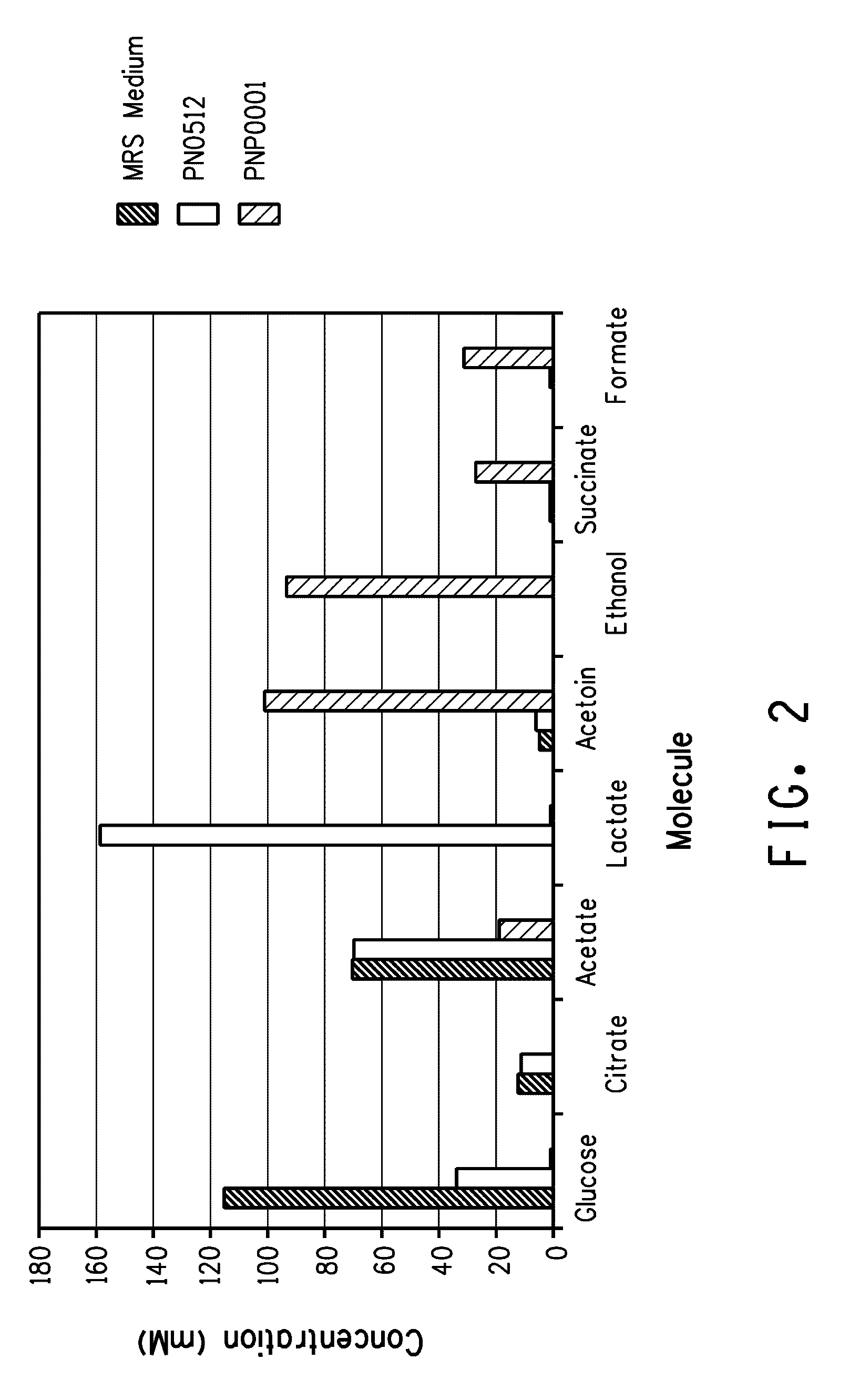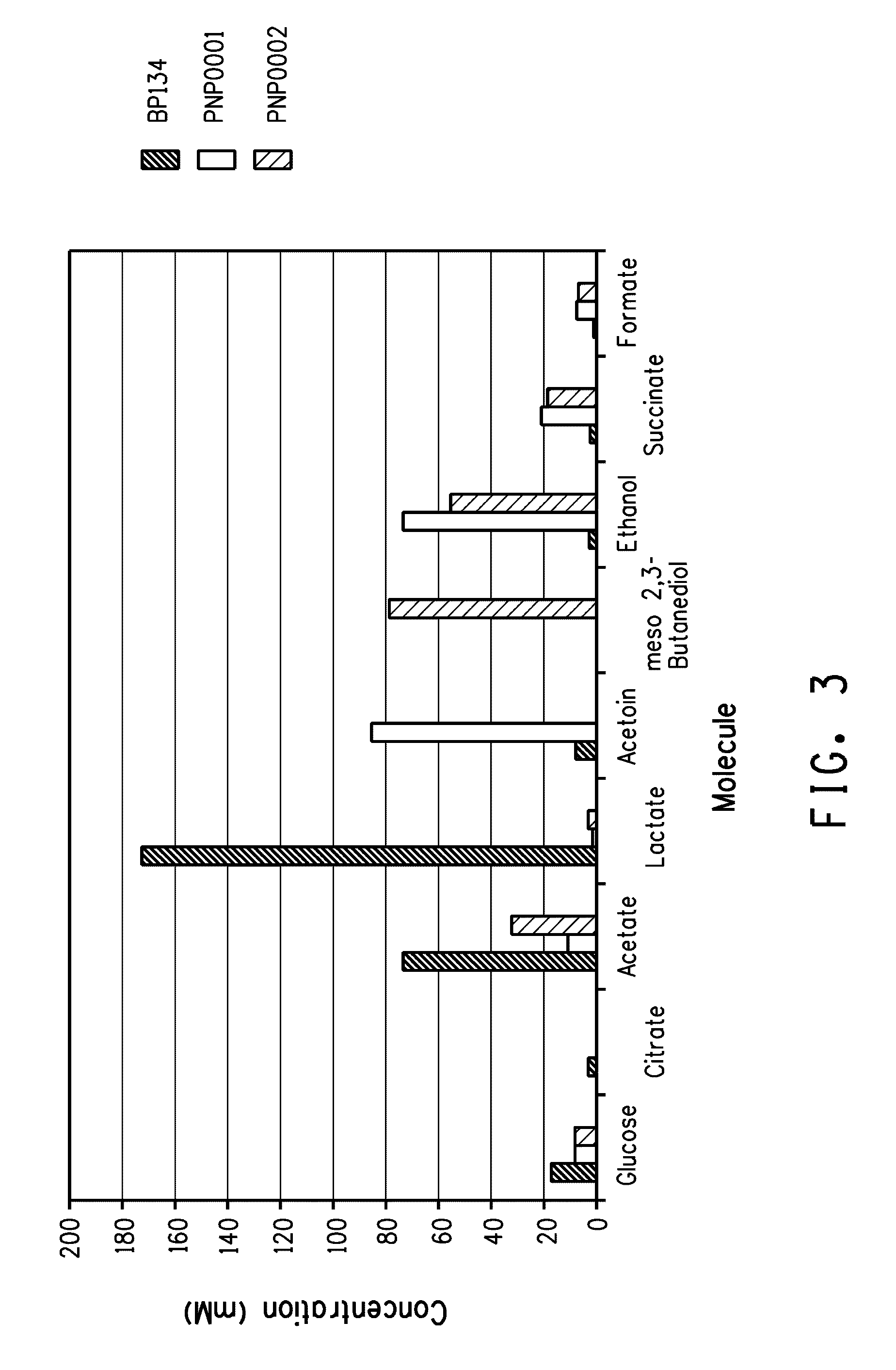Enhanced pyruvate to 2,3-butanediol conversion in lactic acid bacteria
a technology pyruvate, which is applied in the field of industrial microbiology and the metabolism of lactic acid bacteria, can solve the problems of ldh-deficient ethanol production, unpredictable metabolic engineering to redirect pyruvate from lactate to other products in lactic acid bacteria, and reduce the activity of pyruvate formate lyas
- Summary
- Abstract
- Description
- Claims
- Application Information
AI Technical Summary
Benefits of technology
Problems solved by technology
Method used
Image
Examples
example 1
Construction of the Lactobacillus plantarum PN0512 ΔldhDΔldhL1 Strain PNP0001
[0128]The purpose of this example is to describe the construction of a Lactobacillus plantarum PN0512 strain that is deleted for the two genes that encode the major lactate dehydrogenases. The major end product of fermentation in Lactobacillus plantarum is lactic acid. Pyruvate is converted to lactate by the action of two lactate dehydrogenases encoded by the ldhD and ldhL1 genes. A double deletion of ldhD and ldhL1 was made in Lactobacillus plantarum PN0512 (ATCC strain #PTA-7727).
[0129]Gene knockouts were constructed using a process based on a two-step homologous recombination procedure to yield unmarked gene deletions (Ferain et al., 1994, J. Bact. 176:596). The procedure utilized a shuttle vector, pFP996 (SEQ ID NO:35). pFP996 is a shuttle vector for gram-positive bacteria. It can replicate in both E. coli and gram-positive bacteria. It contains the origins of replication from pBR322 (nucleotides #2628 ...
example 2
Product Analysis of a Lactobacillus plantarum Strain Deleted for the Two Lactate Dehydrogenases, LdhD and LdhL1
[0138]The purpose of this example is to demonstrate the products produced by the Lactobacillus plantarum PN0512 double ldhDldhL1 deletion strain compared to the wild-type strain.
[0139]Strains PN0512 (wild-type) and PNP0001 (ΔldhDΔldhL1) were grown in rich medium, Lactobacilli MRS medium (Accumedia, Neogen Corporation, Lansing, Mich.), at 30° C. without shaking under anaerobic conditions in an anaerobic chamber (Coy Laboratories Inc., Grass Lake, Mich.). Both cultures were grown to a similar OD600 about 8.5. PNP0001 grew at a rate that was approximately 2.5 times slower than the wild-type PN0512. In order to reach a similar OD600, strain PN0512 was grown for 16 hours and strain PNP0001 was grown for 41 hours. Cultures were centrifuged at 3700×g for 10 minutes at 4° C. and culture supernatants were filtered through a 0.2 μm filter (Pall Life Sciences, Ann Arbor, Mich.). The f...
example 3
Construction of Plasmids for the Production of meso-2,3-butanediol
[0141]The purpose of this example is to describe the construction of a plasmid for expression of a heterologous butanediol dehydrogenase. The ldhL1 promoter region (SEQ ID NO:8) from L. plantarum PN0512 was amplified with primers AA135 (SEQ ID NO:61), containing EcoRI, SpeI, and AflII sites, and AA136 (SEQ ID NO:62), containing an XhoI site, from PN0512 genomic DNA using Phusion High-Fidelity PCR Master Mix. The resulting PCR fragment and pFP996 were ligated after digestion with EcoRI and XhoI to create vector pFP996PldhL1 (SEQ ID NO:36).
[0142]A secondary alcohol dehydrogenase encoded by the Achromobacter xylosoxidans sadB gene (coding region SEQ ID NO:9 and protein SEQ ID NO:10) was disclosed in U.S. patent application Ser. No. 12 / 430,356. The sadB coding region was amplified with primers oBP112 (SEQ ID NO:50), containing XhoI, NheI, and EcoRV sites along with a ribosome binding site (SEQ ID NO:51), and oBP113 (SEQ I...
PUM
| Property | Measurement | Unit |
|---|---|---|
| temperature | aaaaa | aaaaa |
| temperature | aaaaa | aaaaa |
| temperature | aaaaa | aaaaa |
Abstract
Description
Claims
Application Information
 Login to View More
Login to View More - R&D
- Intellectual Property
- Life Sciences
- Materials
- Tech Scout
- Unparalleled Data Quality
- Higher Quality Content
- 60% Fewer Hallucinations
Browse by: Latest US Patents, China's latest patents, Technical Efficacy Thesaurus, Application Domain, Technology Topic, Popular Technical Reports.
© 2025 PatSnap. All rights reserved.Legal|Privacy policy|Modern Slavery Act Transparency Statement|Sitemap|About US| Contact US: help@patsnap.com



